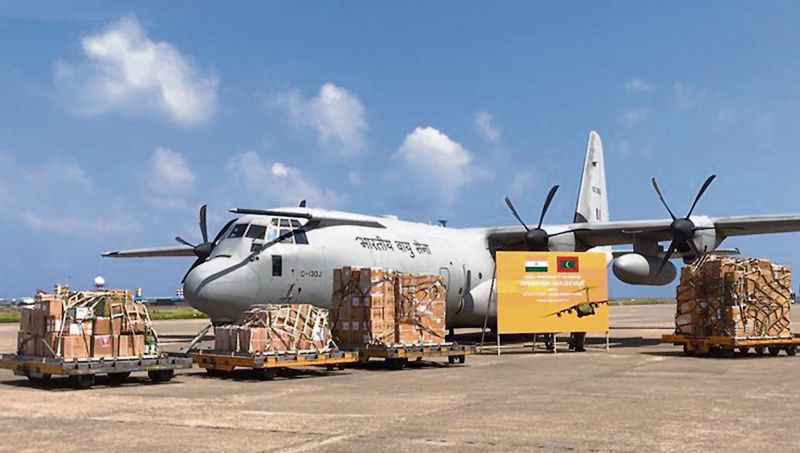Humanitarian Assistance and Disaster Relief (HADR) serves as an important diplomatic tool whilst assisting neighbouring nations during natural disasters. India had helped Pakistan after the 2004 earthquake. But Pakistan refused Indian assistance during the recent floods, much to the agony of its citizens. If relations were better and MoUs had been in place between our countries, India could well have stepped in to provide aid to Pakistan.


HUMANITARIAN Assistance and Disaster Relief (HADR) has traditionally been an important peacetime mission for the Indian armed forces. The recent accretion of heavy-lift C-17s, all-terrain C130 J Super Hercules aircraft and Chinook helicopters have added substantial capability in this domain.
Operation Sanjeevani was launched during the worst days of the Covid pandemic to move medical supplies and specialists to different parts of the country and the neighbourhood. Enhanced aerial wherewithal, along with appropriate MoUs with friendly neighbouring nations, orchestrated by an efficient triservice organisation under the Chief of Defence Staff, is expected to further hone our country’s capabilities in HADR.
The evacuation of 58 Indians from Iran after the Covid outbreak in March 2020, 76 Indians and 36 foreign nationals from Wuhan (China) in February 2020, besides the transportation of much-needed medical supplies to China and ferrying of over 336 tonnes of medical supplies, rations and other commodities all over the country since March 2020 have been the notable HADR achievements of the IAF in recent years.
Medical assistance to the Maldives and Nepal has, likewise, been a part of the recent HADR efforts. The IAF’s inherent strengths of range, mobility and flexibility have enabled and continue to enable effective HADR in our neighbourhood in peacetime Non-Combatant Evacuations (NCEs) and from war zones such as Iraq and Yemen, too.
The IAF’s HADR assumed credible proportions during Operation Sea Wave relief, rescue and evacuation during the 2004 tsunami, which impacted India, Sri Lanka, the Maldives and Indonesia. The IAF quickly provided HADR succour to several citizens in Sri Lanka, the Maldives and as far out as Indonesia. The breakdown of the RO water plant in September 2014 saw the IAF lift 374 tonnes of drinking water to the Maldives via Op Neer.
India sent cyclone relief to Fiji in February 2016 and was the first responder to provide medical assistance and relief supplies to cyclone- and flood-hit Sri Lanka and Bangladesh in May 2017.
The HADR serves as an important diplomatic tool whilst assisting neighbouring nations during their trying times caused by natural disasters. The recent climate change-induced floods in most of Pakistan, more so in Sind and Baluchistan, have seen over 1,700 casualties. India had helped Pakistan after the 2004 earthquake. But that country refused Indian assistance during the recent floods, much to the agony of its suffering citizens. If relations were better and MoUs had been in place between our countries, India could well have stepped in to provide HADR to Pakistan.
Another area where the IAF’s speedy assistance could be of use to the neighbouring nations is that of organ transplant. Especially in key organ transplant situations, such as for hearts and liver, time is of essence to facilitate safe implantation in the recipient. Like, for heart transplants, the donor heart has to be installed in the recipient in a four-hour time frame. Depending on the harvest locality, air transportation of the organ is critical to meeting time frames and widening the areas of organ availability, more so in a large country such as ours.
With suitable MoUs in place, this could also be extended to friendly neighbouring countries by facilitating medical air ambulances and other high speed means of organ transportation between hospitals in the subcontinent.
Depending on the distance of the organ harvesting station and the receiving unit and the time criticality of having the organ installed, the IAF could consider higher speed platforms for transportation, including fighter aircraft, if need be, considering the goodwill that would be generated by such missions within the country and also between donors and recipients even in the neighbouring countries. Norway employed an air force F-16 to bring an entire heart-lung machine to a critically needy patient. This, of course, is for the air force top brass and the government to take a call on.
One recalls the Timber Trail helicopter rescue of passengers from a crippled cable car at Parwanoo, near Chandigarh, 30 years ago. As demonstrated therein, the payoffs of an HADR mission are out of proportion to what is to be normally expected. Even in comparatively inconspicuous locations and ordinary victim profiles, the media along with the IAF’s public relations setup would ensure that considerable mileage is derived for the service and crew involved. And where foreigners are involved, naturally, the eyeballs would tend to get accentuated, besides, of course, directly contributing to bilateral goodwill between the nations.
Frequent HADR exercises and appropriate standard operating procedures would contribute to the credibility of the IAF and government agencies. Close cooperation between the IAF HQ and MEA would, of course, be called for to ensure smooth prosecution of overseas HADR missions. Joint HADR missions, such as high sea rescues and assistance to hijacked ships or skyjacked aircraft, would pose peculiar inter-service challenges.
Search and rescue of civil aircraft would be another key area of HADR for the IAF professionals. The deputation of IAF medical teams to friendly countries and possible air ambulance roles may also be envisaged.
A joint survey of the topography of vulnerable areas is another aspect for the planner. Even if mission capability exists for undertaking such out-of-area contingency operations, proper memorandums of understanding with the neighbouring countries ought to be in place to avoid confusion.
Besides these, considering the international footprint of Indian nationals worldwide, which stands currently at around 30 million heads, the possibilities of unforeseen evacuations from trouble spots are high, indeed. Performance in war situations is the raison d’être of any air force, no doubt. But the great goodwill generated in the country and internationally by way of successful HADR missions adds mettle to any air force’s viability as a guarantor of national security.
